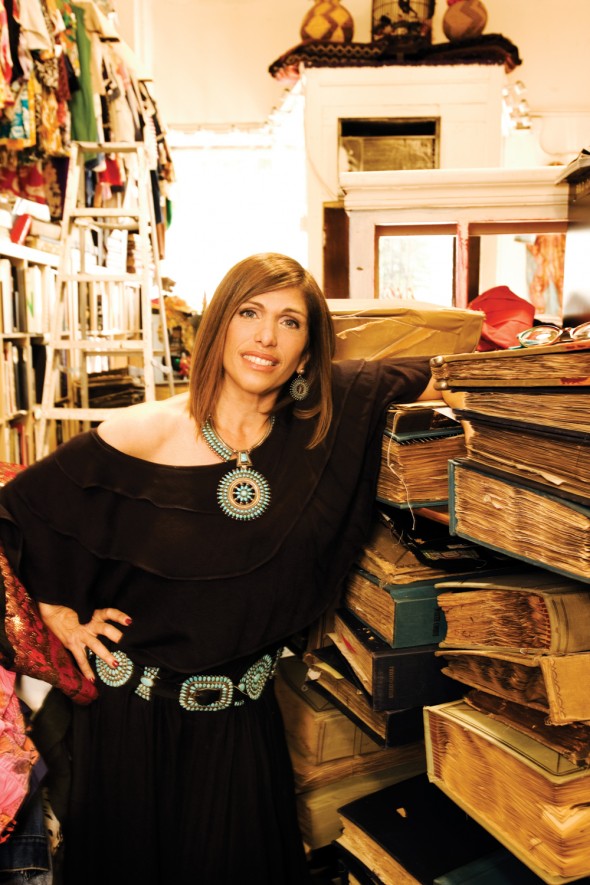Vintage treasure seeker Doris Raymond pays homage to the way we wore.

Photography by Angela Kohler
It’s mid-morning on La Brea Blvd in Los Angeles and Doris Raymond, proprietress of The Way We Wore vintage shop, has Drew Barrymore and Jessica Lange on the brain. A Vanity Fair stylist is dressing the actresses for a shoot themed on their upcoming film Grey Gardens, and asked Raymond to assemble a rack of silk kimonos. Indeed, no one in la is better suited to the task.
The Way We Wore is the culmination of Raymond’s life’s work and is no ordinary vintage shop. She estimates that the 1500 sq ft space and adjacent reference library holds 8000 pieces spanning the entire 20th century. Though packed to the brim, it is meticulously organized—no trolling through musty-smelling castoffs takes place here, where rack after rack, each piece is priceless.
“We wanted to make the store on this level chronologically, so that neophytes would get a sense of the evolution of styles. It starts with the Edwardian-Victorian at the front corner and it goes through ’20s, ’30s, ’40s, ’50s, and on the other side starts the ’60s, the ’70s and the ’80s.”
Raymond herself has the wheat-germed air and clear-eyed earnestness of the San Francisco hippie she was for 30 years. Dressed in a 1980s black peasant dress and heaps of Navajo turquoise, she comes across more like your Anthropology 300 professor than the woman who sells A-listers gowns they will never witness on anyone else walking the red carpet. Perhaps that’s no accident.
“Anthropology is not far off. I would call myself a treasure hunter,” she says. Her favorite decade is the Parisian teens through the ’20s, “because so much happened in the world of fashion. You had Paul Poiret infusing ethnic—kind of the grandpa of the hippie movement. And then in the ’20s, you go from women being completely oppressed and having to dress a certain way right to women’s liberation. From a construction and sociological point of view to me it’s the richest part of fashion.”
On The Way We Wore’s upper floor of gowns and couture items, Raymond coos with pride over a ’70s animal print Diane Von Furstenberg wrap dress bearing the original tags and a ysl tiered black taffeta dress, but blatant branding leaves her cold. She stocks just one small showcase of designer handbags — mostly Chanel and Judith Leiber — that she describes as “iconic, but not in your face, like the lv lv lv. That stuff for whatever reason doesn’t appeal to me.”
Raymond’s vintage journey began as a teenager growing up in Long Island, and since then she’s developed an uncanny ability to ferret out the pieces that, as she says, “transcend time.” “Sometimes when I’m shopping, marathon shopping,” she says, “it’s almost as though I’m in an altered state. It’s like my intuition takes over and I’m just there for the ride. Is it possible that I was a dressmaker in the ’20s and ’30s?”
Raymond’s eureka moment, born of passion and necessity at her first flea market, germinated into a serious business when she opened shop in 1981. Aside from her film industry clients, designers from Zac Posen and Marc Jacobs to Forever 21 send teams to the shop and trade-only reference library, sniffing for inspiration, always leaving with racks of clothes.
Much of Cate Blanchett’s wardrobe in The Curious Case of Benjamin Button was sourced from Raymond’s all-time best score: the estate of a wealthy obsessive-compulsive woman, who bought and, for the most part, never wore 5000 pieces of designer clothing, including rare Danskin leotards in Blanchett’s size.
Perceiving vintage clothing as an avenue to both self-expression and sustainable living, she has extended a challenge called “Out of the Ordinary” to a dozen designers for Earth Day, April 22nd, asking them to transform pieces of vintage clothing.
Much like herself, Raymond’s ideal customer is an iconoclast, “a person who has an idea of their identity, treats their body as a canvas and sees clothing as a way to paint. You know, God bless Juicy Couture and all the other companies that mass-produce products, but I don’t want to look like everyone else. I buy things that talk to me and I wear them because I want people to hear what I’m saying without words.”
— Jasmine Pahl

